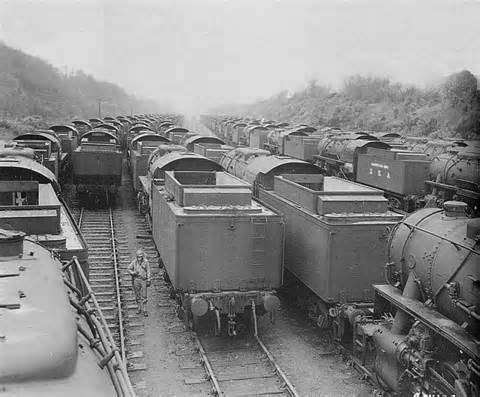Garrattfan's Modelrailroading Pages

Collection
USATC S160
The prototype
An exceptional shot of the KWVR S160 on 27-04-2019. Published with kind permission of ©2019 Craig Philip Szlatoszlavek. |
||||||||||||||||||||||||||||
|
||||||||||||||||||||||||||||
A Lima builder's photo |
||||||||||||||||||||||||||||
A long line in store awaiting their deployment during the invasion |
||||||||||||||||||||||||||||
I met one "in the flesh" at Shildon, National Railway Museum in the UK |
||||||||||||||||||||||||||||
|
One example is in operational condition at the KWVR |
||||||||||||||||||||||||||||
The modelRoco have issue a decent model of the S160 some years ago. I found it way too expensive, with a "normal" price around €450. But when I was at the subject of war locomotives in general and of the Dutch classes NS4300 (ex-WD 2-8-0) and NS5000 (ex-WD 2-10-0) in particular, I stumbled into a reasonably priced example. I was nevertheless set back by €269, but you know when to take your loss :-) But seriously, it is a beautiful loco. Its has a tender drive and the weight of the tender gives it serious oomph. I must admit I feel a bit half-hearted about tender drives, somehow it is not real. Whatever you do, the locmotive's wheels will never slip. :-). It is a tad glossy for a war loco and renumbering it to one that actually worked in the Netherlands will be a small project one day, but for now it sits proudly in my display cabinet. Arrived on 19 June 2018, almost exactly 74 years after the first engine landed on the European continent. |
||||||||||||||||||||||||||||

 During the build-up of forces and material in the run up for the invasion of Europe it was quickly realised how valuable sufficient motive power would be behind the moving front. So the design of the S160 was conceived as early as 1942, only months after the US had entered the war and a good two years before the invasion actually happened. From 1942 to 1946 approximately 2100 engines were built by the main US locomotive builders. Many were transported to the UK well ahead of the invasion and were "run in" on the systems of the Big Four (LMS, LNER, SR and GWR) quite incidentally helping to sustain the logistics of the war effort. After the liberation of the southern part of the Netherlands some served there in service of the USATC. None ever carried Dutch Railways numbers. After the war most were sold off to a great many countries all over the world. At least
During the build-up of forces and material in the run up for the invasion of Europe it was quickly realised how valuable sufficient motive power would be behind the moving front. So the design of the S160 was conceived as early as 1942, only months after the US had entered the war and a good two years before the invasion actually happened. From 1942 to 1946 approximately 2100 engines were built by the main US locomotive builders. Many were transported to the UK well ahead of the invasion and were "run in" on the systems of the Big Four (LMS, LNER, SR and GWR) quite incidentally helping to sustain the logistics of the war effort. After the liberation of the southern part of the Netherlands some served there in service of the USATC. None ever carried Dutch Railways numbers. After the war most were sold off to a great many countries all over the world. At least 



Sign my
GuestBook